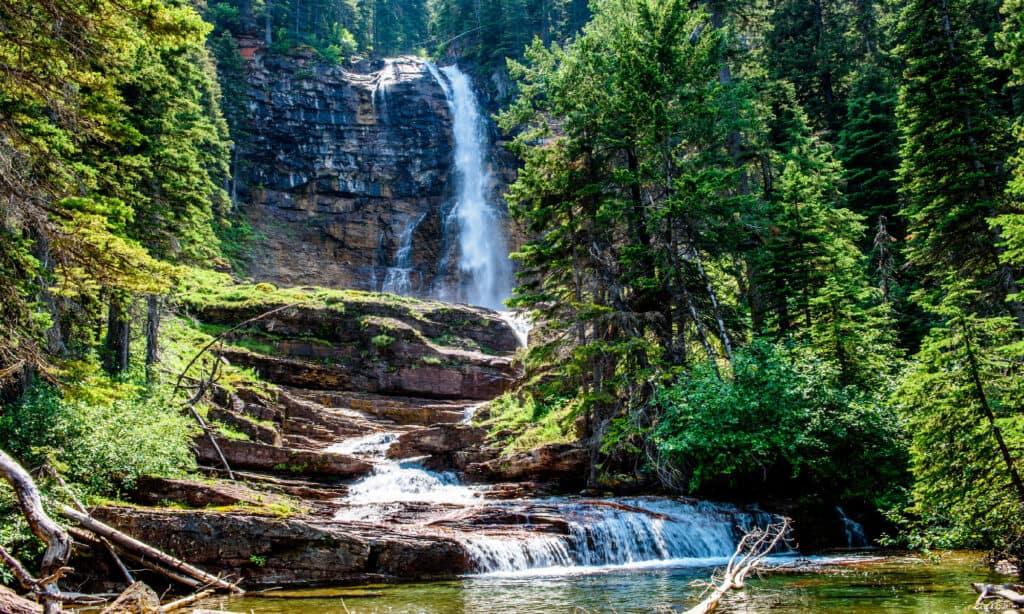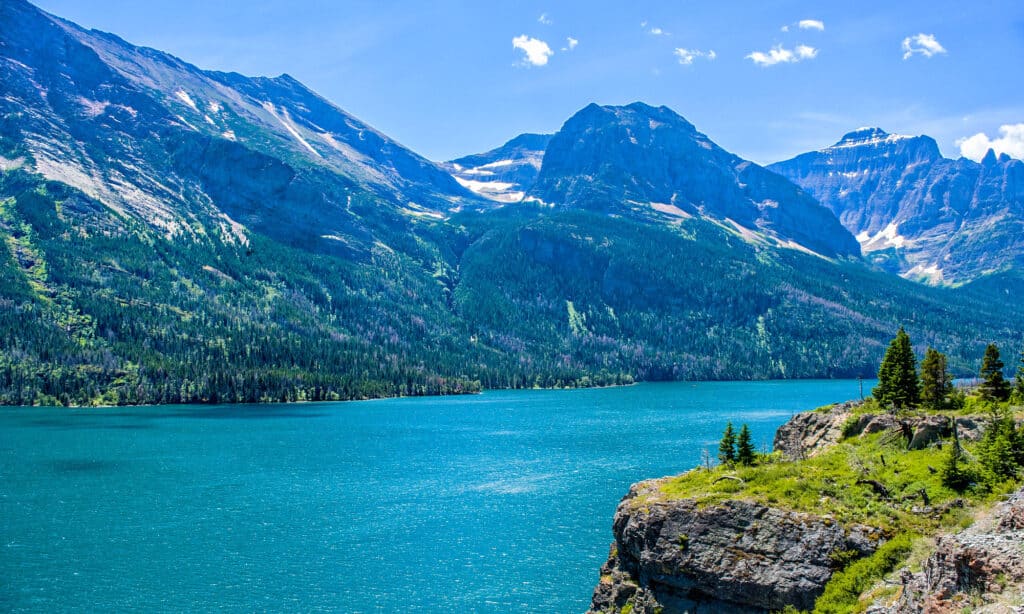The Glacier National Park in Montana is spectacular for many good reasons. A visit to the famed Crown of the Continent will help you understand the well-deserved hype it gets. The Glacier National Park is at the intersection of biodiversity. It hosts mountain ranges, waterfalls, glacier-carved valleys, aspen parkland, prairies, tundra, lakes, and diverse wildlife.
Mountain goats, black bears, bighorn sheep, moose, grizzly bears, and coyotes roam the Glacier’s rocky terrains and alpine meadows.
Can you imagine such magnificent beauty in one place? What a dream place for hikers, wildlife watchers, and adventurers! It is definitely one of the most diverse habitats in the Lower 48.
The Glacier National Park is a Biosphere Reserve, International Dark Sky Park, and UNESCO World Heritage Site. In addition, the first-ever Waterton-Glacier International Peace Park comprises Glacier National Park and the Canadian Waterton Lakes National Park.
Customs clearing is not required to pass through the US-Canada border between the two parks. Enjoy a boat trip to the Waterton-Glacier parks and spend time around the scenic beauty.
Glacier National Park Activities
Since its completion in 1932, the 50-mile Going-to-the-Sun Road mountain road has allowed millions of tourists to explore the national park. The drive runs through pine forests and past breathtaking lakes to the beautiful Logan Pass.
The Logan Pass is the park’s highest point, accessible by car. The route also offers wildlife sightings and stunning views of waterfalls and glacier-carved valleys. Check the website of the National Park Service for updated information about the Going-to-the-Sun Road.
A vacation at Glacier National Park is a vacation well spent. You cannot run out of activities, regardless of your interests. So as you plan your itinerary, ensure you include a drive through the Going-to-the-Sun Road, hiking the Swiftcurrent Pass Trail and kayaking on Lake McDonald. Spotting wildlife along the Logan Pass or visiting St. Mary or Virginia Falls is also popular.
Wildlife in Glacier National Park

As much as it is thrilling to see bears up close, remember that bears pose a threat. So stay alert!
©iStock.com/Tim Speer
Glacier National Park has abundant wildlife species, ranging in size from the big and ferocious to the little and cuddly. Every animal specie has a home in Montana, from rodents to apex beasts, amphibians to reptiles. Likewise, the host state Montana is recognized for its wide variety of fauna.
Its richness is due, in large part, to its sparse human population, enormous mountain ranges, and peculiar climate. The moniker “Big Sky Country” is owed to the state’s abundance of wide-open landscapes and uninterrupted skies.
However, this does not take away from the amazingness of the ecosystems at the Glacier.
Where is the Highest Concentration of Grizzly Bears in Glacier?
Wildlife sightings are one reason so many visitors travel to the Glacier yearly. Bears are one of Glacier’s most sought-after species because many inhabit the park.
Grizzly and black bears roam the park’s vast alpine meadows, forests, and verdant lakeside habitats. Grizzlies are not restricted to these areas; you can see them anywhere within the park. You can also find the bears or their tracks on many hiking trails.
Glacier National Park is a bear country. Therefore, having bear spray is crucial for your safety on every tour, no matter how short. (more on this later).
In April 1983, the grizzly bear was symbolized as the official state animal of Montana by then-Governor Ted Schwinden.
Grizzly bears hibernate during the winter. May to July is their breeding season. They come out of their dens in search of food during the spring when the temperature begins to warm up.
While you may see grizzlies anywhere in Glacier, here are some locations where you stand a better chance. These routes are popular, have an open layout with expansive views, and border some of the best grizzly bear habitats.
Many Glacier Valley
This is the grizzly bear haven of Glacier National Park due to its river valleys, lakes, and waterfalls which are ideal for the sustenance of grizzlies. No wonder it hosts one of the most bear-densely populated regions in the lower 48.
Lake Sherburne may be your best bet for bear sightings along the Many Glacier Road. Pro tip: You have the best chance of seeing bears if you travel this beautiful road late in the evening. Keep an eye out for them as they wander and hunt in the lakeside meadows.
It is also possible to see grizzly bears on the many breathtaking trails in Many Glacier. Grinnell Glacier, Iceberg Lake Trail, Cracker Lake Trail, and Grinnell Lake Trail.
If you stay at the Many Glacier Valley for a few days, you should see at least one bear.
Logan Pass Area
The Logan Pass is the highest spot along the Going-to-the-sun Road. It has an elevation of 6,646ft (2025m) and is one of the most frequented places in the park. The pass is named after the first superintendent of the park, Major William R Logan.
The Logan Pass Visitor Center’s parking lot is typically filled from 8:00 a.m. to 4:00 p.m. during the summer, especially between July and August. It is one of the busiest spots with a vantage view of the Glacier.
Mountain goats, grizzlies, and bighorn sheep are a regular sight here. You have to schedule your visit before sunrise or late in the day. You can opt for the free shuttles to get around the limited parking spaces.
The early morning hours offer more opportunities to spot wildlife and the morning light is perfect for Pinterest-worthy pictures. It’s also the time when parking spaces are easiest to find.
The Hidden Lake Overlook Trail passes directly through the habitat of bears. This is why grizzly bear sightings are common. Sometimes, the park management temporarily closes the trail to safeguard bears and visitors.
The Highline Trail, Huckleberry Mountain Trail, and Trout Lake Trail are popular hikes at Glacier National Park that offer abundant wildlife.
Saint Mary Lake North Shore

Two Dog Flats, a vast area of meadows on the north shore of Saint Mary Lake, is another fantastic location to spot grizzlies in Glacier National Park.
©Evelyn D. Harrison/Shutterstock.com
Saint Mary Lake is the second-largest lake in Glacier National Park after Lake McDonald. Going-to-the-Sun Road runs parallel to the lake’s north shore on the park’s east side.
Many miles of lakefront habitat stretch from the plains at Saint Mary Village to the slopes of the Rocky Mountains at Sunrift Gorge. Keep an eye out for grizzly bears between Sunrift Gorge and Rising Sun on the Going-to-the-Sun Road.
Following the 2015 Reynolds Creek Fire, a young forest is slowly regenerating, and black bears and grizzly bears hunt there. The Sun Point and Rising Sun are separated by sparse vegetation, so it is easy to look for bear activity on the slopes by the roads.
Two Dog Flats, a vast area of meadows on the north shore of Saint Mary Lake, is another fantastic location to spot grizzlies in Glacier National Park. You can sight wildlife at several pullouts around this huge sloping grassland.
You might catch a glimpse of bears roaming these grasslands at dawn or dusk. But, of course, lots of deer and elk are also around.
Piegan Pass Trail, Gunsight Pass Trail, and Siyeh Pass Trail are spectacular hiking routes with tons of wildlife sightings, including grizzlies.
Two Medicine Valley
The Two Medicine Valley is located in the southeast part of Glacier. Two Medicine never fails to dazzle with its breathtaking scenery, despite being less popular than other areas of Glacier.
Look through your binoculars at Two Medicine Lake and search the steep Rising Wolf slope for bighorn sheep, mountain goats, and perhaps even a black or grizzly bear.
The Upper Two Medicine Lake Trail, Scenic Point Trail, and North Shore & South Shore Trails are some hikes for possible wildlife watching.
North Fork Area
The North Fork is in the northwest section of Glacier and has a low visitor count. It can only be reached by private vehicle on gravel roads. The reward for navigating the difficult route includes views of Bowman and Kintla Lakes, Covey meadow, Numa Ridge, and grizzly bear viewing opportunities.
You may also spot grizzlies along the Numa Ridge Lookout Trail, Logging Lake Trail, and Quartz Lakes Loop.
Bear Safety at Glacier National Park

The National Park Service recommends driving at least 91 meters away from a Grizzly bear before stopping.
©Jack Nevitt/Shutterstock.com
As much as it is thrilling to see bears up close, humans must remember that bears pose a threat. So stay alert and treat them with caution.
The amount of personal space each bear needs varies based on their feeling. Their actions are unpredictable, so do not pull over next to a bear if you see one along the road.
The National Park Service recommends driving at least 91 meters before stopping in a secure spot.
Bear spray has remained a cheap but effective deterrent against bear attacks. Carry it at all times and ensure you are familiar with its usage.
Grizzlies have an acute sense of smell and explore anything that seems intriguing to them. Therefore, avoid using scented sunscreen, cologne, or perfume.
The likelihood of being attacked by a bear is considerably reduced when you hike in groups. The Glacier has not documented attacks on hiking parties comprising of four or more people.
Bears usually hide when they hear people approaching. However, bear bells are neither sufficient nor effective.
Do not catch a bear off guard; a better method to announce your presence is to call out and clap frequently.
Up Next
- Witness a Grizzly Chase a Black Bear up a Tree in Glacier National Park
- What Is The Bite Force Of A Grizzly Bear?
- 10 Incredible Grizzly Bears Facts!
The photo featured at the top of this post is © Krishna.Wu/Shutterstock.com
Thank you for reading! Have some feedback for us? Contact the AZ Animals editorial team.






